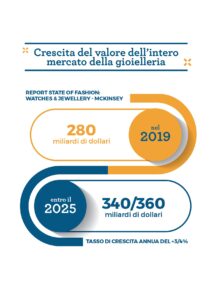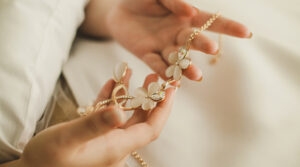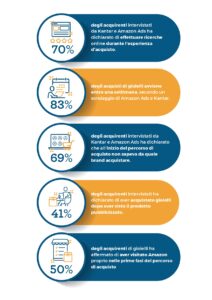Accompanying a newfound post-pandemic optimism, data from the report The State of Fashion: Watches and Jewellery by Business of Fashion and McKinsey show that the value of the entire jewelry market will grow from $280 billion in 2019 to $340-360 billion by 2025, with an annual growth rate of +3/4 percent. Costume jewelry, or costume jewelry, also follows the trend: this market, which in 2018 was worth $25.2 million, is set to double by 2025.
Digitalization is set to dominate strategies and market evolution, beginning with e-commerce. Global web sales could increase from 13% to 21% according to McKinsey projections. However, this transition to online platforms presents challenges, as companies must “humanize” digital experiences to meet consumer expectations for the same level of customer service and attention to detail experienced in physical stores.
Despite the digital shift, approximately 80% of purchases in 2025 will still be made in physical stores, making seamless omnichannel experiences fundamental for success. The winning companies will be those that are most digitalized and transparent regarding sustainability practices.
Sustainability has emerged as a central theme in the jewelry industry. It is estimated that by 2025, 20-30% of global jewelry sales will be influenced by consumers who consider sustainability essential. Both new players and established brands must become increasingly transparent, communicating their environmental and social sustainability strategies and objectives.
Companies that are more digitized and more transparent about sustainability will prevail.
In addition to this, among the trends driving the jewelry and costume jewelry market over the next few years is a greater consumer focus on transparency in the sourcing of materials, in line with the widespread appetite for sustainable purchasing that characterizes all markets..
Amazon, as the largest online store, has become increasingly attentive to product compliance. Manufacturers and importers must work with reliable suppliers who can demonstrate regulatory compliance through supporting documentation.
Test reports must guarantee that tested articles do not contain certain hazardous substances:
- Cadmium: A carcinogenic substance that, until 2011, was present in excessive doses in costume jewelry, particularly in low-cost items
- Lead: Highly toxic, especially for children, with absorption possible through skin, oral, or respiratory routes
- Nickel: A reprotoxic substance dangerous for the fetus and reproduction, also causing skin reactions in nickel-sensitive individuals
- SVHC Substances: Substances considered potentially dangerous by Europe and therefore monitored, including phthalates, organotin compounds, benzene, and others
Having a REACH regulation report ensures greater transparency in product quality terms and makes companies more appealing in the marketplace. All articles sold in the Italian market, including those sold online, must be labeled according to Article 6 of the Consumer Code, and since January 1, 2023, new environmental packaging labeling regulations have been in effect. Data source TÜV Italy (tuvsud.com)

As jewelry purchases increase online, it is important for brands to reach customers with an omnichannel strategy. More than 70 percent of shoppers surveyed by Kantar and Amazon Ads said they search online during the shopping experience. This is why brands might consider creating a consistent shopping experience between online and in-person purchases.
Shoppers surveyed by Amazon Ads and Kantar said that if they choose to shop in a physical store, it is because they prefer the experience of trying on jewelry and directly testing the feel of the product and material. Brands can try to recreate this experience in online stores through real-time engaging content on Amazon Live. Here, customers can see influencers as they interact with products and ask questions. Brands can also use video ads to provide a detailed, 360-degree overview of their products.
The Amazon Ads and Kantar survey found that 83 percent of jewelry purchases occur within a week. Given this very short time frame, jewelry brands may want to be ready to connect with customers before and during the path to purchase. This is why brands may want to consider adopting an always-on approach to reaching audience segments during this purchase journey.
It should be added that customers also buy jewelry for gift giving all year round. Birthdays, anniversaries, holidays, and Valentine’s Day are among the most popular occasions to buy jewelry as gifts. Brands that focus their advertising only on major calendar events may be missing opportunities to reach customers who buy birthday and anniversary gifts year-round.
Finding the perfect necklace, earrings, or bracelet may mean exploring a number of different brands during the buying journey for a shopper. Sixty-nine percent of shoppers surveyed by Kantar and Amazon Ads said that at the beginning of the path to purchase, they did not know which brand to buy products from.

This highlights the importance of reaching buyers before they begin their journey, so that one’s brand is top-of-mind from the moment of search. Advertising can help. 41% of buyers surveyed said they purchased jewelry after seeing the advertised product. In addition, 50 percent of jewelry buyers said they visited Amazon at the very early stages of the purchase journey, which underscores the importance of reaching these audience segments before they make a purchase decision.
It is also true that the notion that jewelry is always synonymous with high monetary value has weakened in recent years, thanks in large part to the advent of synthetic diamonds on the market, which have enabled designers to create amazing pieces at rock-bottom prices.
Somehow, this new trend is shifting the value of a piece of jewelry from stone (or metal) to design. Especially in Eastern countries and among the youth audience, the possibility of buying or giving real jewelry (in the case of some synthetic diamonds, it is impossible to distinguish them from natural ones) on a budget of a few tens of euros has decreased the success of many brands that traditionally dealt in costume jewelry.

But Amazon does not want to stop at industrial products made by big brands: the goal is to become the global benchmark for any merchandise sector.
That’s why Amazon launched the Handmade category back in 2015 to provide the opportunity for small artisans to sell their handmade products on the platform as well.
To qualify for the Handmade category, products must be entirely handmade or assembled by hand.
They must be handmade by you, as an artisan, or by one of your employees if your business has a maximum of 20 employees (or by a collection of businesses with less than 100 employees in total).
The categories of products you can sell on Handmade are very elastic: they range from jewelry to household products, from personal care products to accessories….
But is it worthwhile for a small artisan to sell handmade on Amazon? Let’s look at the pros and cons of this opportunity.
Sales volumes often turn out to be directed by the price aspect, resulting in the danger of being within an industry where identifying the “right” final cost for the customer is a matter of pennies.
The dangers are certainly greater if one is going to import costume jewelry products from abroad, from suppliers whose products are perhaps of poor quality, while this danger is reduced in the case where the costume jewelry product has “handcrafted” particularities, that is, it is made in a “unique” and fully distinctive and recognizable manner. Given the high crowding of the category, however, it is important to consider the centrality of visibility actions “off” the platform, activating their social channels as a priority.
